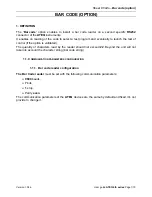
RadioProcessor-G
I. Introduction
Product Overview
The RadioProcessor Model G™ is an enhanced version of SpinCore's versatile RadioProcessor™ design. The
RadioProcessor-G greatly expands upon the already extensive capabilities of the original RadioProcessor with the
inclusion of three channels of user controlled gradient outputs. For more information on the general operation of the
RadioProcessor, please refer to the RadioProcessor manual, which can be found on this webpage:
http://www.spincore.com/products/RadioProcessor/RadioProcessor.shtml
The state-of-the-art design of the RadioProcessor-G allows it to serve as a complete system-on-chip solution for
Magnetic Resonance Imaging (MRI), Nuclear Magnetic Resonance (NMR) applications in gradient enhanced
spectroscopy and diffusion measurements, and Nuclear Quadrupole Resonance (NQR) experiments with spectrometer
frequencies from 0 to 100 MHz (refer to the RadioProcessor manual for more details). The system integrates SpinCore’s
high-performance PulseBlaster™ timing engine for agile control of internal system components as well as TTL
pulse/pattern generation for control of any external hardware.
The RadioProcessor-G:
•
Is a system-on-chip solution for MRI, NQR, and NMR applications, integrating excitation and acquisition
components onto a single PCI card.
•
Contains three analog output channels that allow for applications requiring pulses of varying amplitude and
timing.
•
Directly captures and digitally demodulates IF/RF signals. The desired baseband bandwidth is user definable
through software.
•
Generates completely formed RF excitation pulses as well as high resolution digital control signals.
•
Maintains signal coherence between excitation and acquisition systems at all frequencies.
•
Autonomously averages baseband signal data between multiple acquisitions.
This unique digital system is housed on a small form factor PCI card, providing users with a compelling
price/size/performance proposition unmatched by any other device on the market today.
2017-09-04
5
www.spincore.com






































